| | OK, Camcoat did their wonderful thing and left me with a manifold coated inside with a ceramic insulator, and outside with a dissipator. The effect is to maintain energy in the gasflow and help control under-bonnet temperatures. And the pipes cool down much faster than otherwise too.
The car then went on the back of my friend Norman's transporter to visit Alastair at Stainless Creations in Falkirk. Despite his slightly dodgy website and its distinct impression that everything is about 4.5" pipes on Scoobies, the bulk of his work is the sensible (ie affordable) repair of exotic German exhausts.
We talked, he listened, and I left it to him, The result was a single big-bore pipe to a simple box that has left me at about 98db at sound checks. I have already recommended him to others.
Now I'm exhausted, and need to sit down....
|
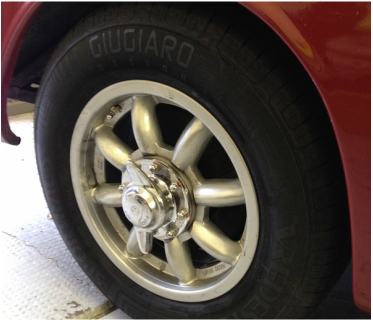 The wheels, or at least the tyres, on the bus were a bit of a shocker at Bo'ness last year. I have two sets: Dunlop L section crossply racers on 5.5" wires, that are not road legal; and a selection of curiously old Semperit and Goodyears on standard 5" wires. Only after Bo'ness in 2013 did I read the DOT codes on the road tyres and understand why they seemed hard. I have also done my share of polishing chrome wires on the Morgan - and had no desire to return to that as a regime.
Where I ended up is with a set of modern compound, 70 profile, Vredestein Sportrac 5's on 5.5 Minator alloys that use splined adaptors in chromed steel. The Minators came off ebay and, although the rims were good, the Rudge-Whitworth adaptors had deteriorated and desperately needed to be rechromed.
When I first viewed the car in Denmark, Kaj was quite straightforwardwith me that he had encountered a problem with the exhaust system. The LCB manifold was a pure 'B' item and it simply did not fit. In fact it was in full, permanent contact with one of the chassis tubes. So every time the engine moved it separated from the chassis before clanging back onto it. The result was not just a bit of noise but a whole clattering and banging that left me wondering what had just fallen off.
When I began to ask around the first thing I was told confirmed that 'B tubular manifolds dont fit Gilberns'. I did wonder if the BL ST manifold might fit, as it famously clears the steering on LHD B's in a way many others dont, and I thought about buying one from Moss to give it a spin. But found I did not have to.
Browsing other sites I found that Maniflow, near Salisbury, said 'Gilbern' right between F for Ford and H for Hillman. Surely not I thought. But a call to Dave Dorrington (ex Downton all those years ago) confirmed that he actually had a Gilbern GT jig and that he'd be happy to stick his favourite competition 'B' pipe sizes onto it for me. He goes up one size on the diameter of the centre branch, which has to flow more, with a 2" tailpipe exit.
After six weeks it popped up (Dave's got a waiting list!) and it looked great. It was suitably compact, with good bends and impressive weld finish. But would it fit?
The combination of rebuilding my workshops and a need to get a tincan racer together for the Scottish Hillclimb Championship continues to keep me away from the Gilbern. But I have been running it around the block to keep it alive. One practical thing that struck me doing this is that I have bunches of keys that dont seem to work too many of the locks on the car. And I wondered if I could fix that?
Apart from the ignition, the one lock that works satisfactorily is the petrol filler. I believe this was a Gilbern specific item. But the result is entirely academic as the filler is unused, disconnected in favour of the little foam-filled alloy tank that sits in the boot.
More practical would be locking doors. The passenger lock kind of works, on Tuesday when the wind is from the west etc - so after a bit of joogling. The driver's lock does not, even on one of those Tuesdays. So a couple of new barrels sounded like a good idea if I could identify the handles.
Following some prompting from Brian, the Club GT Historian, I looked around contemporary Fords. Lo, they popped up as MK1 Cortina.
Fortunately the Mk1 has a busy owners club. And having secured membership for thirty earth pounds, the spares secretary was able to offer a pair of matching lock barrels and some new gaskets to go between the handles and the doors - no sense in taking the handles off to put them back on without gaskets. In fact Bob was good enough to spend an hour and a half raking through all of the stock, to label the barrels with their numbers and find me a matched pair. Bob - thank you! Finally, the boot catch is a bit dodgy - as well as missing a key. But that looks like an early Mk1 Mini and a barrel should be easily found.
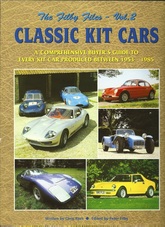 I have not been on here at all recently - a seasonal combination of Christmas, skiing and rebuilding my workshop has kept me away from what I should be doing.
But while I was idling my time away our club historian (Brian) dropped me an email to tell me that 70 DNR appeared in 'The Filby Files' book on Classic Kit Cars. I was worried when I heard that, never having thought of it as a kit car (which it never was!), but I picked a copy off ebay a couple of weeks later and found it littered with lots of things like TVR's and even Lotus 7's.
And there, squeezed between Gilbern GT and Gilbern Genie was a picture of my car in earlier days. So the editor had clearly struggled a bit with his alphabet as well as his definitions. Although, to his credit he recognised the car as an 'underrated and quite Collectable sports GT car'.
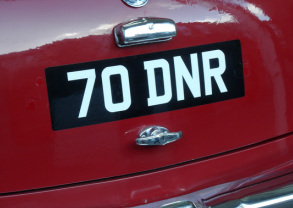 Strange but true, DVLA drifts towards a personal evaluation by me of 'helpful and efficient'. I'm not really sure that's true at all. But it is certainly how I felt after a new V5 dropped through my letterbox confirming the return of the car's original registration - 70 DNR.
A couple of days later I was back at the Edinburgh DVLA office to sort out a tax disc. Of course, in issuing the V5 they had not changed its previous taxation class, which was private/ light goods. This had to be altered to 'Historic' to allow me to secure the tax disc at 'no charge'. And the helpful and efficient (you see it's creeping in again) lady at the DVLA office corrected this online and handed over the tax disc. I was happy.
In a wave of optimism I had previously ordered a couple of white-on-black number plates on 'sticky-back plastic'. These were lightly trimmed to a better width, but before fitting them I decided to 'glass up the holes in the bootlid. This I did with my elder son, taping a release film on the outside of the lid and filling with coloured gel-coat, plugs of mat and finishing with tissue - just as it tells you in the book. The match of the gel-coat to the paint was good enough to spare me attempting to paint anything. However, I did offset the rear number plate 5 or 6mm to the right to cover a small patch of white gel coat that was exposed.
We also plugged two holes in the front apron where spotlights had once been fitted. And the picture below shows my younger son wiping any remains of tape from around the area masked with release film.
The finishing touch was a Bo'ness Hillclimb Revival holder for my new tax disc, sourced from Margaret at the club - an essential accessory for all period racers.
What a wonderful weekend we had at the Bo'ness Hillclimb Revival meeting on September 7 and 8. The one aim I had with the car this year was to make it to Bo'ness, and I did.
If you have not heard of this event before, or been there, you should find out more on the Club's own site. It has to be some of the best fun in the calendar, with a tremendous 'gala' atmosphere. This is, after all, the hill that hosted the first ever round of the British Hillclimb Championships and has seen more notable competitors than myself in the past: including Messrs J Y Stewart and J Clark.
Here are links both to the BHCR site, and to John Crae's wonderful galleries of pictures he has taken at recent years' events. John was good enough to provide the pictures of my car here. And 'read more' to learn about my own experience.
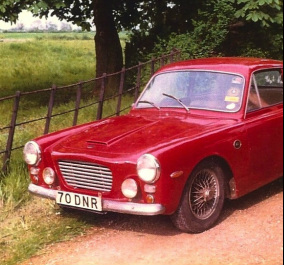 The car had left these shores in about 1980 and subsequently borne a series of Danish number plates. In Denmark registration numbers are unique to the car/ owner combination - so they change each time the car has a new owner. But in the UK, the number is 'stapled' to the car throughout its life (absent someone putting a personalised number on it).
Fortunately the licensing body, DVLA, has a specific procedure that is intended to restore numbers that have been 'lost' to historical vehicles. This uses a procedure described by the name of the application form it uses - the V765. This requires you to present evidence that your car did bear that particular number - DVLA is usually looking for old tax or registration documents, and a certificate from a recognised owners club to back it up. Other documents I would need were an MOT certificate (roadworthiess test) and insurance certificate.
So I wanted to recover the car's original registration number if it was still available, 70 DNR. But this was to be neither obvious nor easy....
One problem that became apparent as I worked on the wipers was a fuel leak. With the ignition on and the fuel pump chattering away, there was a growing patch of petrol on the floor inside the left rear tyre. It was small but insidious - a bunch of polyester resin dripping in VPower would certainly 'keep the home-fires burning'.
My immediate solution was simply to disconnect the fuel pump earth so I could get on with the wipers. I would return to investigate this later.....
Getting under the car with a wheel off I could see the culprit was a short length of flexible fuel hose that joined two hard lines high in the rear arch, which would get wet and drip when the line was pressurised. The problem was a jubilee clip, just out of sight, that had to be tightened.
However, as I looked further downstream I realised the offending connection was only 30cm short of a factory fuel pipe union joining two lengths of hard line. Then checking upstream, the flexible hose was fixed again to the original hardline that disappeared into the boot. In the boot it had now gained another flexible hose connecting it with the fuel regulator - but only after passing through a stepup connector to get it from 6mm to the 8mm ID demanded by the regulator outlet.
So this one metre of fuel line started with a metal union and then ran through six jubilee clips to get it only as far as the fuel regulator. A classic case of 'just one more clip' being added by multiple owners over many years. While Bo'nes was too soon to allow for any radical replumbing, I figured I could at least replace that stretch of hose with something more robust.
Having resolved to do it, I pulled its entire length between the metal union and fuel regulator. Then realised I was holding something that looked like a 3/4 scale model of a mediaeval Welsh rice flail, bristling with jubilee clips.
A quick call to the very helpful folks at Speedflow had them prepped to confirm the size of the metal union connection and ship me the -6 braided hose I needed. I sent the union to them that day (Monday) and they were on the phone on Tuesday to tell me it was threaded 1/2-24UNF, which was an unusual size. Fay recommended a self-forming JIC alternative and I had the bits I needed in my hands on Wednesday. Unfortunately they would be 'out' of the nylon-braided hose I wanted to try until Thursday, and Bo'ness was on Saturday - so cutting it too fine to wait. Hence I opted for a less-flexible, but hugely robust, stainless-braided hose.
Working with this hose, it certainly helps to following the instructions and use a brand new 32T hacksaw blade, but I found putting it all together to be a coast. As was fitting the new JIC union to the hardline. I tied it all down and there was not a drip in sight.
Another requirement for the car to gain its MOT (roadworthiness test) was to reinstate windscreen washers. The reservoir had long disappeared, with some of its wiring and plumbing. And the windscreen washer jet was missing, well, its jet!
Starting with the washer jet, I found the item was common to the Daimler Dart and earlier Cobras. It was probably used on a number of other plastic cars of the era as it had the merit of being held to the bodywork by two screws. The good news was knowing its source; the bad news was finding that these are entirely unobtainable.
Fortunately, I found a substitute (designated for the Dart) from David Manners. This consisted of a small, machined pedestal that presented an 8mm hole into which a conventional twin-jet washer could be bolted. Expedient and reassuringly expensive.
The reservoir and pump should be a Lucas 2SJ, another electro-mechanical wonder of its age that delivered a measured volume of water for each 'hit' of the momentary dashboard switch. I shall save that story for another day, when I have one that is adequately restored. But, in the meanwhile, my son and I reinstated the cable runs from where they had been terminated adjacent to the wiper motor. And we fixed a cheap eBay reservoir and pump in the correct location for the 2SJ that will eventually follow.
|
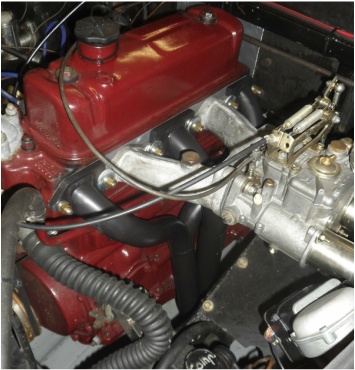

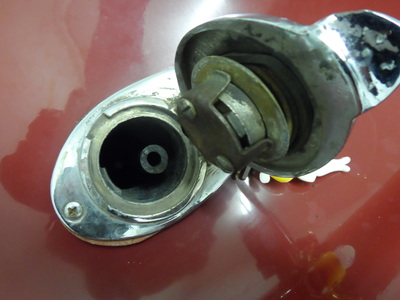
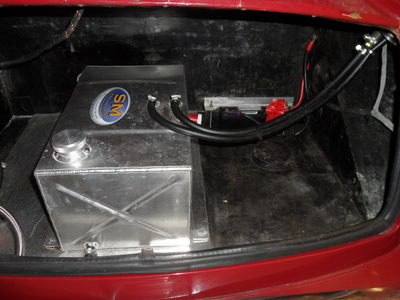
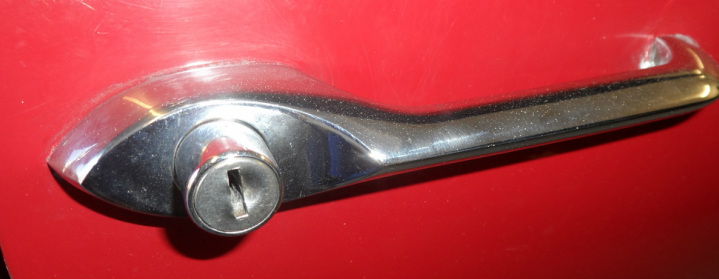



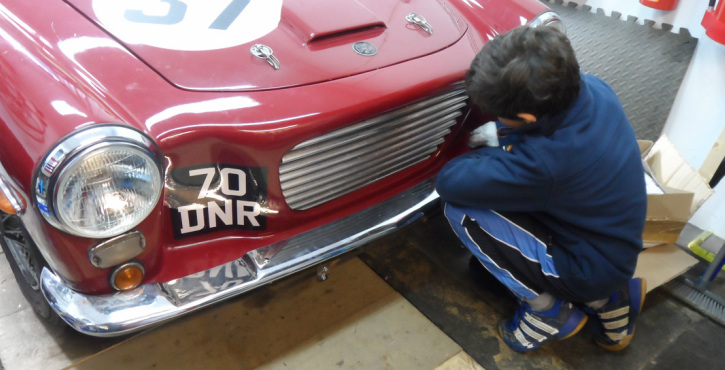
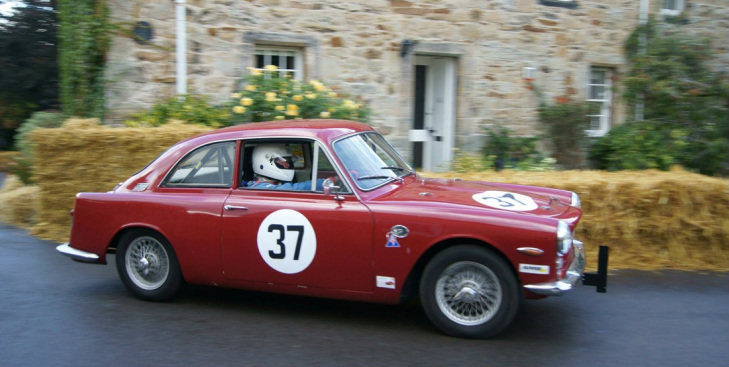

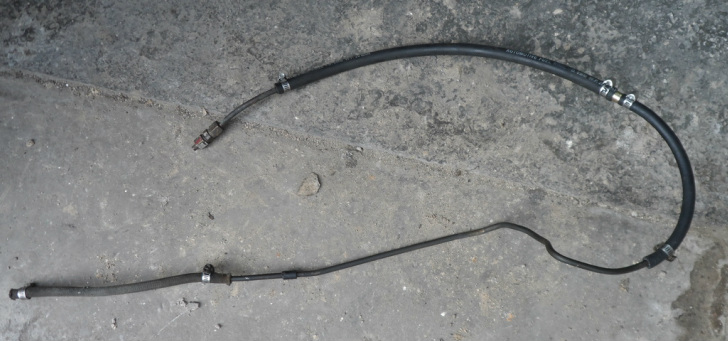
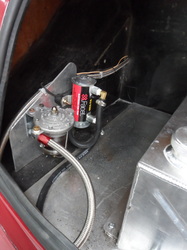
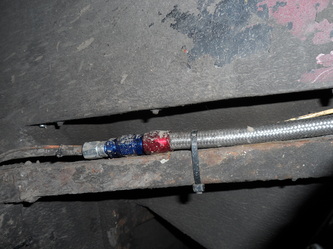
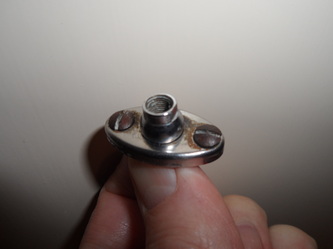
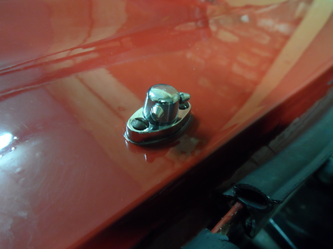
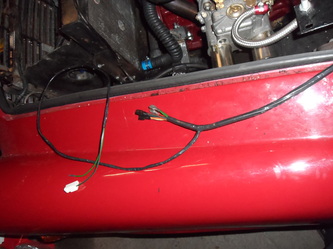

 RSS Feed
RSS Feed